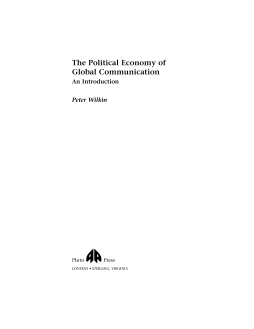
Additional Information
Book Details
Abstract
Recent debates surrounding human security have focused on the satisfaction of human needs as the vital goal for global development. Peter Wilkin highlights the limitations of this view and argues that unless we incorporate an account of human autonomy into human security then the concept is flawed.
He reveals how human security is a concern with social relations that connect people in local, national and global networks of power, structured through capitalism and hierarchical inter-state systems.
Autonomy, as an aspect of human security, depends upon the ability of citizens to gain information about the processes that shape their lives. In this respect autonomy and communication are inherently linked and are prerequisites for the establishment of meaningful democratic systems.
Table of Contents
| Section Title | Page | Action | Price |
|---|---|---|---|
| Contents | v | ||
| List of Figures and Tables | vii | ||
| Figures | vii | ||
| Tables | vii | ||
| Acknowledgements | ix | ||
| Introduction | 1 | ||
| 1. Understanding Human Security | 4 | ||
| Human Security and International Relations | 4 | ||
| Defining Human Security | 5 | ||
| Security and the Study of International Relations | 7 | ||
| Global Communication and Human Security | 16 | ||
| Global Communication and World Order | 18 | ||
| Communication, Human Security and the Public Sphere | 21 | ||
| 2. Towards a Global Communications Industry | 24 | ||
| Global Communication? A Historical Overview | 24 | ||
| States and Mass Communications | 27 | ||
| The Political Economy of Global Communication - Understanding the Transformation of Media Markets | 29 | ||
| Technology, Ideology and Social Power in the Political Economy of Communication | 31 | ||
| Neoliberal Political Economy | 39 | ||
| The Impact of Neoliberal Political Economy - Globalising Tendencies | 40 | ||
| A Qualitative Change in Global Communication? | 46 | ||
| Global Communications? The Changing Structure of the Communications Industries | 47 | ||
| Global Communication and the Changing Structure of Ownership and Control - From Synergy to Oligopoly | 48 | ||
| Globalisation and the Information Society: an introduction | 51 | ||
| Conclusions: Problems for Human Security | 52 | ||
| 3. Human Security and Global Communication - Into the Twenty-First Century | 53 | ||
| Knowledge, Power and Rationality | 53 | ||
| Communication Needs and Human Security | 59 | ||
| Developments in the Political Economy of Education | 65 | ||
| Global Communication, Information and Human Security | 71 | ||
| Neoliberal Political Economy - Idealised Brutality | 72 | ||
| Conclusions: Obstacles to Human Security The Limits of the Neoliberal Analysis | 80 | ||
| 4. Public Sphere, Private Power - The Limits to Autonomy and Human Security | 83 | ||
| Developments in the Public Sphere | 83 | ||
| A Neoliberal Utopia? - The Information Society Considered | 86 | ||
| Conclusions: The Good Society? | 94 | ||
| 5. Building the Perfect Beast: The Information Society Revealed | 96 | ||
| Democracy against Capitalism? The Neutered State | 108 | ||
| Human Security, Autonomy and the Information Society | 113 | ||
| Conclusions: Human Security and the Public Sphere in an Age of Information | 123 | ||
| 6. Global Communication, Human Security and the Challenge to the Public Sphere | 125 | ||
| Globalisation and Human Security | 125 | ||
| Globalisation From Above ( GFA) | 126 | ||
| Globalisation From Below ( GFB) | 131 | ||
| The Global Public Sphere and Human Security | 133 | ||
| Notes | 136 | ||
| Introduction | 136 | ||
| Chapter 1 | 136 | ||
| Chapter 2 | 138 | ||
| Chapter 3 | 141 | ||
| Chapter 4 | 142 | ||
| Chapter 5 | 142 | ||
| Chapter 6 | 144 | ||
| Bibliography | 145 | ||
| Index | 160 | ||
| ABC, | 49 |
